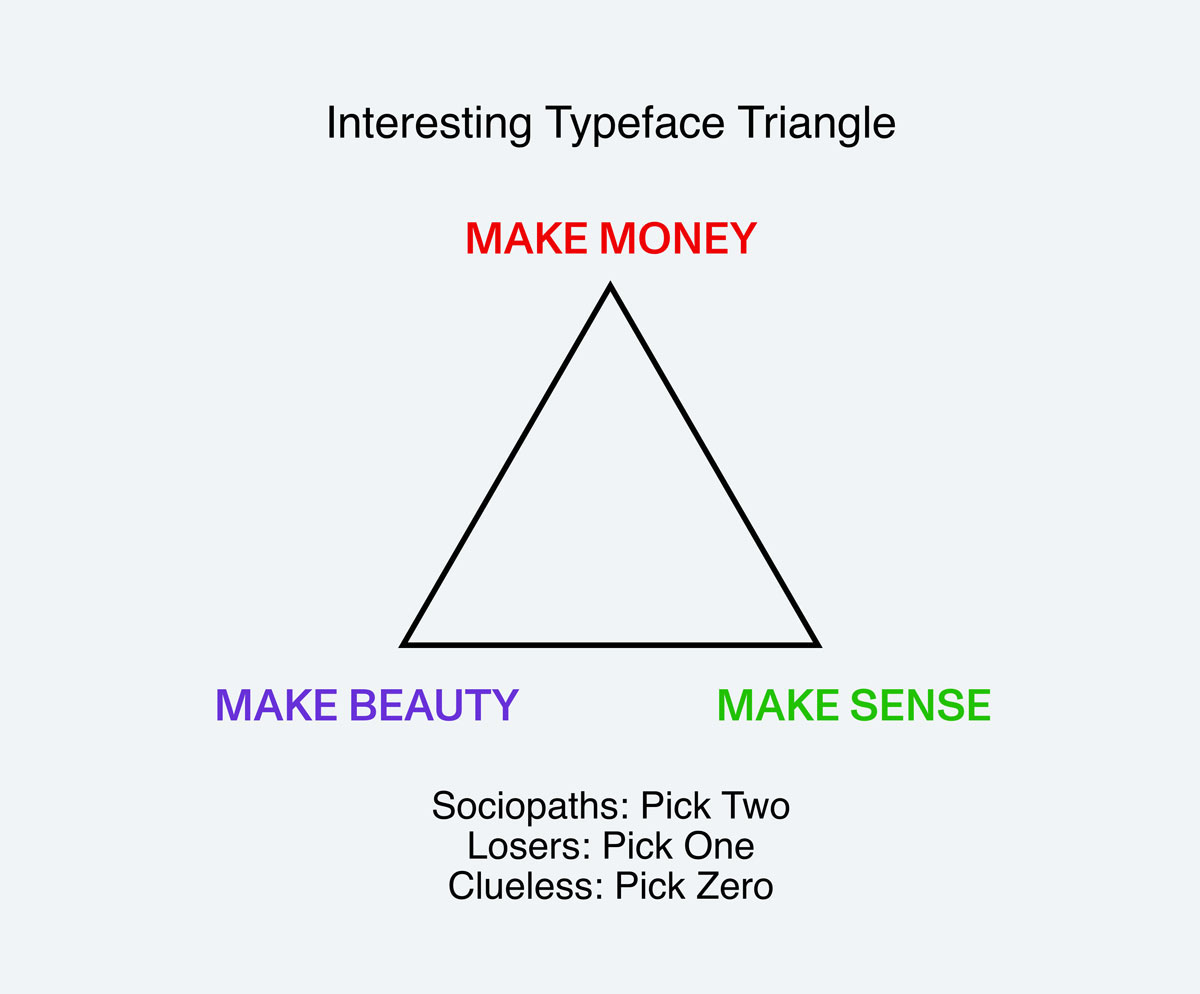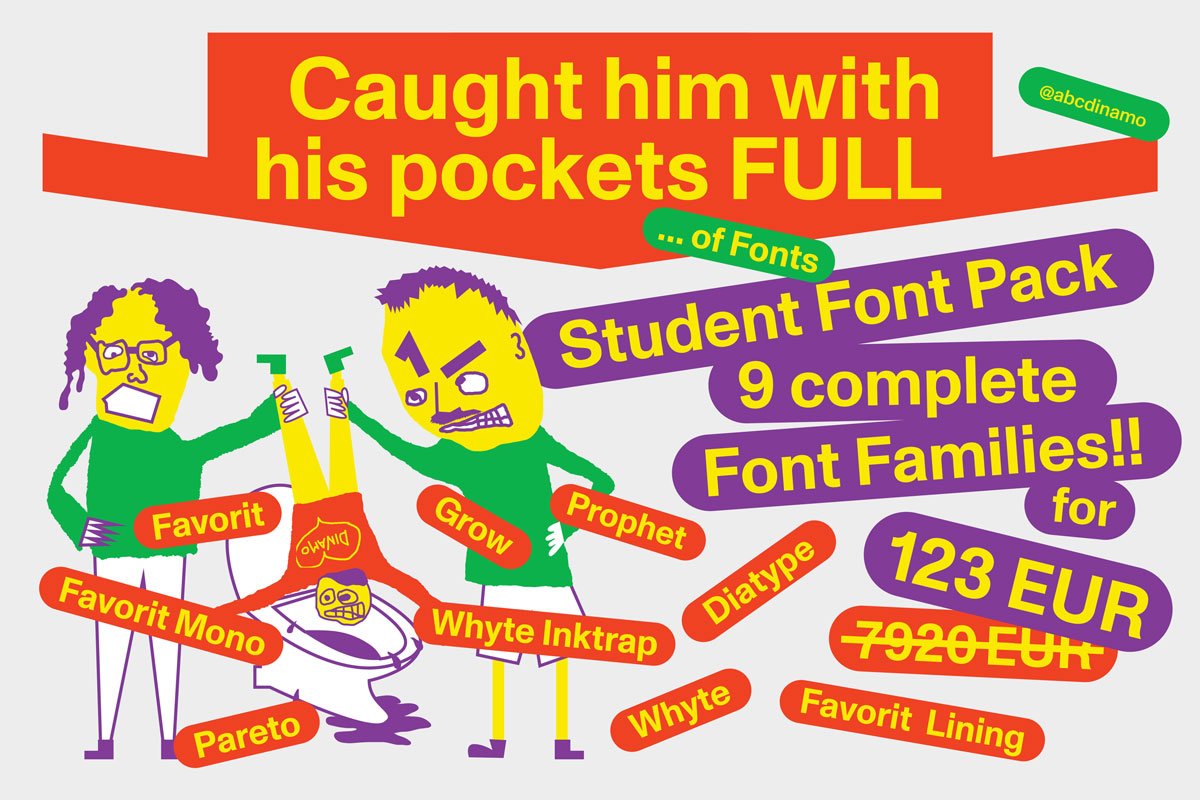Anyone who’s ever had an experience in the font buying business will probably be able to tell you that it isn’t all that straight forward. Despite fonts being crucial in design every day, the whole process of purchasing them can be difficult to understand; often requiring so much work that type designers and foundries become distracted from their getting down to their main occupation—actually designing fonts. There needs to be better education, for both clients and designers, about the process font buying and the specifics of licensing to promote a better understanding of where the money goes and why.

One issue that seems to crop up a lot is that under currently popular systems of font buying, many clients and designers often lack the understanding to see where they’re going wrong—meaning that it’s very easy for type designers and foundries to be underpaid or, to be frank, ripped off. In fact, many brands may not even include the cost of purchasing a font in their budget at all, let alone the cost of actually buying the correct license. Having already developed their own alternative font buying system, independent type foundry Dinamo Typefaces (@abcdinamo) have just the kind of future-facing perspective we need to be paying attention to. We speak to Dinamo to discuss what freelancers, agencies and studios need to know in order to support the font buying business, how to put this knowledge into practice, and what Dinamo’s model of ‘value-based’ pricing means on the ground. Step forward, Dinamo…

What do you think are the most common problems in the field of font buying today?
Before switching from the traditional font licensing model to a new one, we spent so much time explaining and negotiating with our customers. As a small foundry, we found that these long conversations distracted from our actual work, which is to make fonts. We think that’s a common problem for many foundries, and it’s also a problem for customers. When someone chooses a font, it’s quite an exciting moment: it’s like finally deciding to buy that special pair of jeans. But what we started to notice is that right after that decision is made, it becomes a frustrating process, and that’s an issue.
Say a designer wants to use ABC Favorit and they’ve spent a long time making that decision, the next step is that they have to figure out the license. Maybe their client doesn’t even know that fonts cost money though, which is often the case, and suddenly the designer is having to sell the client something they didn’t even know existed. The designer is then getting asked about web traffic or App downloads by the foundry, but maybe the company is a new one so doesn’t even have those metrics yet. There are so many possible dead ends to the conversation—the designer is confused, we’re confused, the client is confused. The designer also becomes a mediator, and there’s this complex triangle of negotiation taking place. It becomes a totally unexciting process for something that should be exciting.

And what do you think is the most serious problem?
We’ve figured out that when using the usage-based licensing model, often bigger companies win. They get the cheaper price. This is because small companies are often structured in a way where different staff members do different types of work: one person might do three different jobs—maybe design, development, and marketing—whereas in a bigger company, there are whole teams dedicated to those different fields. So if the small company would license a typeface based on how many computers use the font, that might be three computers because it has a small team who do a lot. But if a mid-sized company with a design department of three people would license a font based on how many computers use it, that would also be three computers. It then pays the same price as the small company. But the bigger company extracts a lot more value from the font, because the bigger the company is, the bigger its marketing and reach.

Have you had any thoughts on how this could be changed?
Our fonts are now priced based on the company size of the font’s license owner—the client commissioning the design work—rather than the number of people who use the fonts. We call this value-based pricing. So we no longer count how many devices a font is used by, or how much traffic a website or app receives. If everyone were to adapt to the simpler model we use, everyone’s life would be improved. And it’s already happening: week-by-week a new foundry relaunches using our pricing model—it’s really exciting. The concept of value-based pricing hasn’t entirely arrived in people’s minds yet though, so getting them to understand how it works is next challenge. You have to clearly explain to your customers why you have a different model. We’ve found that all our clients understand it quite quickly though. To make a change across the industry, it’s just a matter of establishing this new system and getting enough big players to pick up on it so that it becomes the standard.

Do you think that innovation in the world of font buying needs to happen in order for the industry to improve?
Totally. As much as it’s about making the tools, we also need to think about how to best get those tools out to the people that use them. Movie making doesn’t end after the movie has been filmed and edited, you have to make sure it gets to cinemas, that it can be streamed, that people know about it. We would say working all that out is 50% of the job, just like weightlifting is 50% about what you eat combined with getting a good night’s sleep.
How can a design studio or agency change their methods so that purchasing fonts is done in the best manner?
Designers need to tell their clients right from the start that fonts cost money. A lot do, but a lot don’t, so they get into this situation where they’ve finished a project and now need to buy the fonts, and their client doesn’t understands why the project costs more money. Adding typeface licensing costs to your initial design quote right from the start helps avoid confusion or problems with clients down-the-line. It’s important to try to make the client understand the value that quality typefaces bring to the table, and the many hours and minds that it takes to create them.
When studios purchase fonts on behalf of clients, what is the most common thing they get wrong?
The standard licensing model, where you define a set amount of computers that use the font, doesn’t reflect how data is circulated today. It could make sense if you have just 10 hard drives with the fonts on them. But now, everything is in the cloud. Projects are stored on GitHub. Files are seamlessly circulating—and actually the number of computers they are used on can’t be properly counted, and it shouldn’t have to be. The idea of what one computer is is also outdated—my phone is also a computer.

How does your own pricing system work & why have you chosen to do it this way?
As mentioned earlier, we now use a value-based pricing system. The steps for buying fonts are quicker and easier to navigate, as you really only need to know one number: company size. That’s how we price our Web, App, Desktop and Print licenses. Company size means: how many people work for a company in total. No other metric is needed. We’ve done this because we believe that individuals, small companies, and institutions should not have to pay the same price for typefaces as large companies. In other words: companies should pay relative to their revenue potential. It’s much fairer for everyone involved.
To help streamline the conversation between designer, foundry and client, we’ve also changed who the license owner is. Often, a designer purchases typefaces and uses them for one or several clients. Alternatively, an agency purchases fonts, creates work, and shares both—including the font files—with its client. When we worked as designers in the past, we did the same! But it creates an unfair situation, because it’s the client that eventually benefits from the design work. Therefore the client should be the entity that owns the work and licenses to everything involved in a commission. And actually, taking this thought a step further, the designer should be rewarded for using the font and making the whole license possible in the first place!

Thank you, Dinamo! You can read more about Dinamo’s pricing and new licensing model on their website now.










